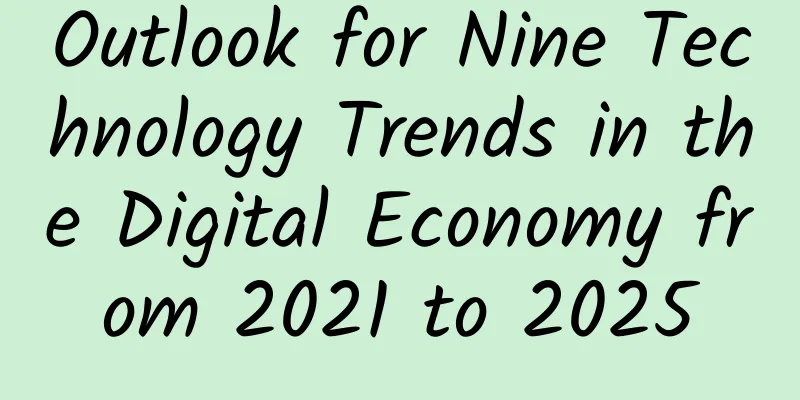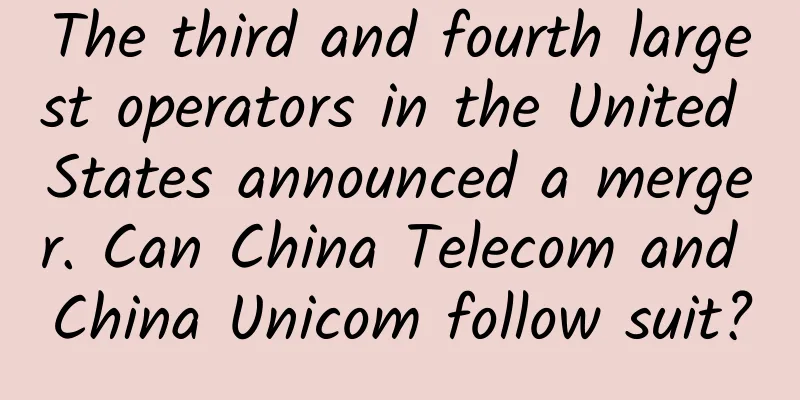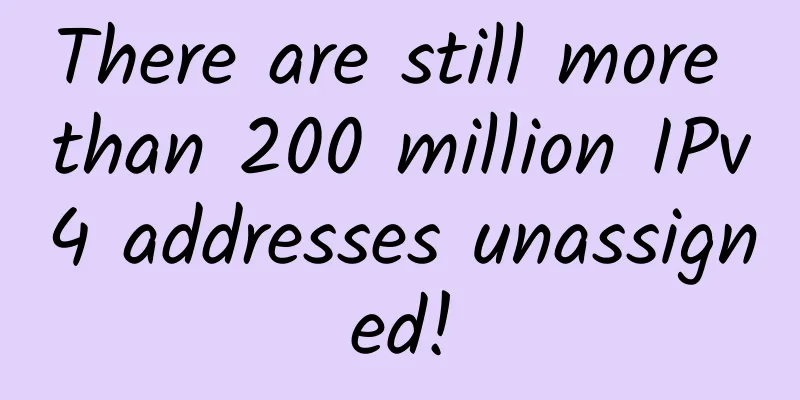Outlook for Nine Technology Trends in the Digital Economy from 2021 to 2025

|
The digital economy is divided into three stages: digitization, Internet (fixed Internet & mobile Internet & Internet of Things), and digital twins. It is currently in the second stage. The development of digital economy varies from country to country, region to region, industry to industry, and enterprise to enterprise. my country is currently in the middle stage of digital economy. Technological progress has an increasing impact on social development, and production methods, lifestyles, and business models are evolving at an accelerated pace. Overall, social productivity demand has driven technological progress, and technological progress has further driven economic development. Based on this, the author predicts the development trend of key technologies in the digital economy in the next five years in the following article. 1. Internet and Internet of Things 1. The migration from toC in the first half of the Internet to toB in the second half With the rise of the Internet ecosystem of major Internet companies, the entire toC Internet ecosystem has entered an era of oligopoly by Internet companies and even complete monopoly in some areas. As a result, the era of land grabbing in the toC market has ended. It has become difficult for small and medium-sized Internet companies to gain market share and grow bigger and stronger through simple investment and entrepreneurship. The entire Internet ecosystem has entered the second half. The second half is the huge toB era. Internet companies, telecom operators, and software companies have rushed into the toB main battlefield. In the next five years, toB is expected to generate a huge market of 20 trillion yuan, focusing on enterprise cloud computing, industrial digitalization, industrial design, industrial Internet, intelligent manufacturing, virtual private networks, digital twin factories, industrial robots and many other fields. 2. Industrial Internet: Consumer Internet and Industrial Internet are gradually connected Consumer Internet promotes the great development of the mobile Internet era. Consumer demand is a rigid demand with the strongest driving force. Offline consumer activities interact with online consumer activities. In 2019, online consumption accounted for more than 53% of the retail sales of social goods. Although the growth trend has slowed down, online consumption has incomparable price and efficiency advantages, which can slow down or even partially level the CPI increase and delay the social pressure brought by inflation. During the COVID-19 epidemic in 2020, the willingness to consume online reached more than 70%. However, we should also see that there is a bottleneck between the online economy and the improvement of industrial manufacturing capabilities - the gap between consumer Internet and industrial Internet. In the next five years, the focus of the industrial Internet will be to gradually fill this gap. The industrial Internet platform cannot only focus on toB. Its most fundamental source of vitality comes from the consumer Internet. 3. Internet of Vehicles: The digitization of cars and roads is the prerequisite for Internet of Vehicles Although it has been developed for about 20 years, the Internet of Vehicles is still in its infancy. The most fundamental reason is that road traffic and vehicle manufacturing have high safety standards. The current Internet of Vehicles, intelligent connected cars or driverless technology systems are essentially the digitalization of cars and roads, car-road collaborative networking, and digital twin transportation. The digitalization of cars and roads is the premise and foundation. If we skip this step and talk about driverless driving, it will be a castle in the air. Losing the premise of safety will obliterate a lot of innovation. In the next five years, only by considering digitalization from the source of automobile design and manufacturing, road design and infrastructure, and traffic control, and keeping pace with the Internet of Vehicles technology, can the development of the Internet of Vehicles be accelerated. my country's policy of promoting electric vehicles is precisely the opportunity and time window for automobile digitalization. The digitalization of roads requires private Internet of Things companies to play a leading role and be combined with the unified layout of traffic management departments. 4. Mobile Internet: Second-tier mobile Internet application apps enter the era of "vertical and horizontal alliances" According to the scale of Internet companies, mobile Internet application APPs can be divided into first-tier, second-tier, third-tier, and fourth-tier Internet applications. Behind the rapid development of Internet giants, many second-tier mobile Internet application APPs with core technologies are on the verge of life and death, while tens of thousands of third-tier and fourth-tier Internet applications have collapsed. In the next five years, if these second-tier APPs want to survive, they must integrate vertically and horizontally, connect their strengths, and avoid duplication of construction and vicious competition. Only in this way can the Internet ecology present a pyramid shape, rather than a monopoly of Internet giants and disorderly expansion of capital. The most fundamental foothold for the sustainable development of the mobile Internet industry is to form a healthy competition in the industrial chain with technology as the core. 2. Cloud Computing 1. Cloud-network integration: a stepping stone for telecom operators to develop government and enterprise industries In the toC field, Internet companies have seized the huge business opportunities and community needs of the mobile Internet and formed a monopolistic Internet ecosystem, while telecom operators have missed an important window of transformation; in the toB and toG fields, cloud-network integration provides an important entry point for telecom operators. China Telecom believes that cloud-network integration contains four layers of meaning: the network is the foundation, the cloud is the core, the network moves with the cloud, and the cloud and network are integrated; China Mobile has reconstructed the cloud-network architecture for the toB market, and continued to build a cloud-network-edge industry private network. Combined with the N+31+X mobile cloud layout, it has proposed a cloud-network integration strategy of "one cloud, one network, and integrated services"; China Unicom has launched seven major products including cloud networking, cloud networking, cloud dedicated lines, cloud broadband, Unicom Cloud Shield, video intelligence boutique network, and financial boutique network. Cloud-network integration is a major development trend in the future, and will be gradually upgraded from IaaS/PaaS/SaaS, and the market value will gradually increase. Therefore, in the next five years, telecom operators' cloud-network integration will develop in the direction of SaaS. Telecom operators' government and enterprise services based on cloud-network integration will have a large market space in the future, and they will have incomparable advantages in terms of network compared to Internet companies. 2. SaaS cloud service: A new giant in China's marketing SaaS will emerge The development of the domestic digital economy has shifted from imitating and learning from the development history of Europe and the United States to independent innovation. Taking public cloud as an example, SaaS services can bring huge cost savings to enterprises. Compared with Europe and the United States, the domestic SaaS industry has great potential. Taking Salesforce as an example, its market value is more than 100 billion US dollars. It started with sales automation and is the pioneer of the SaaS industry. Its business includes CRM, customer service, marketing and other fields. Other well-known SaaS companies include Workday (human resources), ServiceNow (IT services), Atlassian (online development collaboration platform), Zoom (video conferencing), hopify (mall website building system), etc. The total market value of these companies has reached trillions of US dollars. It is foreseeable that in the next five years, super SaaS platforms will also be born in China. We hope to see enterprises other than giants such as BAT, such as telecom operators, software companies, and cloud service companies, flourish and new SaaS giants emerge. 3. Cloud storage services: Cloud storage based on mobile Internet social networking will explode With the in-depth development of mobile Internet social platforms, social software is gradually extending from toC to toB. The socialization of corporate organizational structures is also changing the new ecology of mobile Internet. The usage rate of email mailboxes is declining, and many ordinary file exchanges are migrating from email mailboxes to social software. Along with this comes the bottleneck problem of mobile phone storage. Five years ago, the mainstream mobile phone storage was 64G, and now it is 256G. In the next five years, the cost of mobile phones is rising, which will give rise to the explosion of mobile Internet, social software, and personal and enterprise cloud storage markets. 3. Digital Twin 1. Digital twin cities will move from the embryonic stage to the growth stage The connotation of a digital twin city is to re-map the physical environment and management process activities in the urban environment in a virtual digital environment during the construction of urban information, and to achieve efficient and sustainable urban management methods through the digital twin concept and a unified platform. The development of digital twin cities is gradual, and the concept of digital twin cities has not been widely promoted. However, since its concept follows the principle of materialism, that is, to twin a city in the digital world, no matter how the smart city process develops, digital twin cities are an insurmountable stage, and the evolution must follow the following laws: gradually expand from the construction industry to park planning, urban planning, public safety, transportation, water conservancy, commerce, tourism and other industries, from single buildings to building complexes, economic development zones, parks, and entire cities, from flat 2D maps to 3D maps and 3DGIS maps, from building BIM to urban CIM, from simple plane display to three-dimensional, VR, and holographic projection display, from the most basic urban construction to urban safety, urban governance, urban services, and industrial development, and gradually evolve from single intelligence to group intelligence and urban computers. 2. Digital twins expand from high-end equipment manufacturing to the entire industry Because the highest process precision is required, digital twins originate from high-end equipment manufacturing, and their application value is greatest in this field. Using 3D digital design technology and pre-equipment technology, 3D design workstations are used to design parts and assemblies, replacing the manual drawing work of thousands of people required for high-end equipment in the past. The full 3D digital design development cycle is shortened, the amount of rework is reduced, the quality is higher, the cost is lower, and the competitiveness in the international market is better. Digital twins are also expanding from high-end manufacturing to consumer goods manufacturing and infrastructure. 4. Big Data 1. Data legislation expands from smart cities to all fields Is data a property right or an intellectual property right? The author believes that it is neither, because both property rights and intellectual property rights are more about the scope of industrial civilization, and data is a product of the digital economy era. Therefore, data rights are a new type of property rights that are different from property rights and intellectual property rights. Only by clearly defining data property rights can data flow reasonably according to market rules and capital gains laws, thereby reducing information islands and avoiding falling into the digital divide. The current data legislation is still similar to policy guidance. In the future, a new legal system with the "Data Law" as the line will be formed around data legislation. In the future, local big data management bureaus will be similar to real estate bureaus and intellectual property management bureaus, with the functions of management, registration, supervision and guidance of the market. 2. From data infringement to data awakening my country has the world's largest Internet consumer group, and Internet companies collect users' search, browsing, and purchase data. In the past, users could only passively receive information push or transfer it to third parties. As people pay more and more attention to personal data, data infringement is attracting strong attention from consumers, and netizens are beginning to enter a state of data awakening. Data awakening will also promote national legislation on data rights. 5. Blockchain 1. Blockchain positioning: the contract mechanism of the digital world In the industrial economy era, transactions were agreed upon and realized through the breach of contract clauses in tangible contracts; the digital economy era also requires a credit mechanism, but the difference is that it is in a digital environment, and the essence of the market economy is a credit economy. If mutual trust in transactions cannot be achieved through a safe and reliable mechanism, the cost of market transactions will be extremely high. Blockchain gives the digital world a new contract mechanism. The decentralized and distributed accounting method makes the credit mechanism flat and crowdfunded, which is in line with the characteristics of equality and sharing in the Internet economy. 2. Digital currency enters the commercialization stage The current financial system in the physical world is also based on the industrial economy, and the digital economy era will inevitably call for a new financial system. Fan Yifei, deputy governor of the central bank, once clearly stated that the digital currency of the People's Bank of China should adopt a two-tier operating system. The People's Bank of China first exchanges digital currency to banks or other operating institutions, and then these institutions exchange it to the public. Unlike paper money, all transaction processes involved in every penny are traceable, which achieves an effect that cannot be achieved in the physical world. In the era of digital currency, corruption, online money laundering, and Internet financial fraud will have nowhere to hide. Internet financial P2P based on the traditional currency model of the industrial economy will regain vitality in the era of digital currency. 6. 5G Technology 1.5G construction has entered the stage of large-scale development from the introduction stage Before the advent of the 4G era, mobile communication technology lagged behind market demand. The ubiquitous network connection that people generally expect, from fixed Internet to mobile Internet, is a visible market demand, activating a rich market format. However, for 5G networks, market demand has not been fully tapped. Therefore, in the next five years, China's 5G will still slowly move from the introduction stage to the scale development stage. The marginal benefits of migrating from 4G to 5G in various industries are not obvious. The popularity of various applications such as VR, industrial Internet, 8K HD, and cloud desktops will drive the demand for 5G networks. The killer application of 2.5G is the Internet of Vehicles In addition to the huge consumer group in the personal market, there is also a super-large market, namely the Internet of Vehicles. By the end of 2020, the global car inventory had exceeded 1.5 billion, of which China had 270 million. The fundamental of the Internet of Vehicles in the future is to improve the degree of digitization of vehicles during the automobile manufacturing process, so that various data of vehicles in static and driving conditions can be realized through the Internet of Vehicles to achieve vehicle-road collaboration and vehicle-vehicle collaboration, rather than relying solely on mobile Internet. To develop, the Internet of Vehicles needs to get rid of its dependence on mobile Internet and the Internet of Things, but to digitize cars and roads, and use cars as a mobile Internet of Things terminal, so that Internet of Vehicles terminals become standard equipment when cars leave the factory, thereby promoting the rapid development of the Internet of Vehicles. 7. 6G Technology 1.6G standard will explore a new era of IoT integration Compared with 5G, 6G will not only significantly improve capacity, bandwidth, and latency, but will also be more closely integrated with the physical world, production, and life. 6G will be the era of terahertz waves, which have the advantages of microwave communication and optical wave communication, namely high transmission rate, large capacity, strong directionality, high security and strong penetration. Terahertz waves were proposed by the United States in 2004 and listed as one of the "top ten technologies that will change the future world". Its wavelength is between 3μm and 1000μm, and its frequency is between 300GHz and 3THz, which is higher than the highest frequency used by 5G, namely 300GHz of millimeter waves. The antennas of 6G systems will be nano-antennas. In the era of 4G and 5G mobile Internet, mobile phones can achieve location positioning, read QR codes, NFC functions, altitude, number of steps, etc. The Internet of Everything (IoE) is defined as combining people, processes, data and things to make network connections more relevant and more valuable. Ground base stations are integrated with satellite communications to truly cover the world. 6G is one step closer, and the network will be everywhere and at all times. Things are networks, and networks are things. This is a new era of integration of things and networks. 2.6G will be combined with blockchain and cloud computing to create a digital twin world 6G will move towards terahertz frequencies, and will introduce dynamic frequency band sharing technology based on blockchain. The sharing of data and technology within the digital world and the interaction between the physical world and the digital world must be completed through a trusted mechanism, and blockchain is more suitable for this role. In addition, the further exponential increase in 5G and even 6G network speeds will create bottlenecks in terminal storage. Technological progress, productivity improvement needs, lifestyle needs, market size needs, etc. are a mutually reinforcing process. Through digital twins, a standardized digital world will be established to better serve mankind. 8. Quantum Technology Quantum information science is an emerging field that combines quantum mechanics with information science and other disciplines. The key development directions include quantum communication, quantum measurement and quantum computing, which are respectively aimed at secure communication, super computing and precision detection, and have broken through the classical limits of information science. Although most technologies are still in the stage of experimentation and pilot demonstration, in the future, quantum technology may become the "new infrastructure" of the smart economy era. 1. Quantum secure communication technology will enter large-scale commercialization Even if different individual particles are far apart, if one changes, the other will change accordingly instantly. Quantum secure communication technology based on optical fiber networks and satellite-to-ground quantum key distribution technology will inevitably be ahead of quantum computing because "quantum supremacy" will come sooner or later. 2. Quantum computing will enter a state of continuous competition in the next five years Quantum computers are provided to users in the form of cloud computing. With the improvement of mobile communication network speed and the bottleneck of storage and computing of mobile terminals, quantum computers will mainly provide computing power services for various intelligent applications in data centers. If we compare it with the development history of computers, quantum computers are still in the vacuum tube era of classical computers, and only prototypes and annealing machines have been completed. Quantum computing is a qualitative leap compared to the von Neumann architecture, and it will take a long time before it can be commercialized. From this perspective, the current data center construction model will continue, but future computing will return from large and ultra-large data centers to edge computing. Just as the development of artificial intelligence will go through three stages: dedicated artificial intelligence, general artificial intelligence, and independent innovation artificial intelligence, quantum computing will also go through three stages: dedicated quantum computing (also known as annealing quantum computing), general quantum computing, and super quantum computing. In the next five years, general quantum computing will enter its embryonic stage. 9. Artificial Intelligence 1. The seeds of general artificial intelligence begin to emerge Just like the transition from industrial economy to digital economy, the stage after digital economy is intelligent economy. Just as the digital economy has sprouted in the industrial economy era, the digital economy era has already had special artificial intelligence technologies, such as face recognition, image recognition, intelligent voice recognition, L4 level unmanned driving, etc., and the integration of three or more of these special artificial intelligences is general artificial intelligence. In the next five years, the sprouts of general artificial intelligence will appear in some mature technology fields. 2. Artificial intelligence will encounter algorithm bottlenecks In the field of deep learning, artificial intelligence will encounter a bottleneck period in the next five years. Machine learning, deep learning and neural networks, using the concept of mathematical sets to understand the relationship between the three, they are included in turn, that is, machine learning includes deep learning, and deep learning includes neural networks. Among them, neural networks with more than four layers can be called deep learning, and deep learning is a typical machine learning. This system will continue to encounter bottlenecks in the past four years and the next five years, indicating that the intelligent economy based on the insufficient development of the digital economy can only be called "embryonic". In short, the driving force for technological development comes from breaking economic bottlenecks, and technological development further promotes economic development, and this cycle repeats itself. Analyzing its key essence is very important for understanding the digital economy and seizing historical opportunities. |
<<: Innovation is the key to 5G's "three good"
Recommend
Will edge computing replace cloud computing? Has the strongest dark horse in the 5G era emerged?
Computers are hundreds of miles apart, but the la...
The latest global ranking of 5G standard essential patents: Huawei first, Samsung second
Recently, IPLytics, an internationally renowned p...
New technology popularization post: What is IPv6+?
Since the Industrial Revolution, wave after wave ...
Routing Design for Large Campus Networks
I am Xia Jie, a lecturer at 51CTO Academy. On the...
Innovatively implement ultra-high bandwidth logic interconnection within FPGA using on-chip high-speed network (2D NoC)
An example of using NoC to optimize encryption an...
What is structured cabling in a network system?
Structured cabling plays a vital role in network ...
Learn more about Zero Trust Network Access (ZTNA)
Traditional perimeter-based network protection co...
Five pictures to solve FTP
FTP Principle and Configuration FTP is a protocol...
How is vmiss? Simple test of vmiss Hong Kong VPS (CN-Hong Kong-BGP)
At the beginning of last month, we purchased the ...
Tencent Cloud Hong Kong Data Center Restocking, Lightweight Server/CVM Cloud Server Optional for New and Old Users
Last month, many friends who wanted to buy Tencen...
How is HostYun? Simple test of HostYun Hong Kong EPYC high bandwidth VPS
A few days ago, we shared the information that Ho...
WiFi signal is strong but speed is slow? Here’s how to fix it!
The company's wireless WiFi signal is strong,...
Dual stack coexistence guarantees application Chifeng City accelerates the construction and application of IPv6 in e-government external network
[[435282]] Chifeng City's e-government extran...
Second wave of 5G: 30 countries launch services by 2023
New network deployments and enterprise momentum a...
In addition to base stations, what else should major cities pay attention to in 5G construction?
It has been a year since 5G was officially put in...









